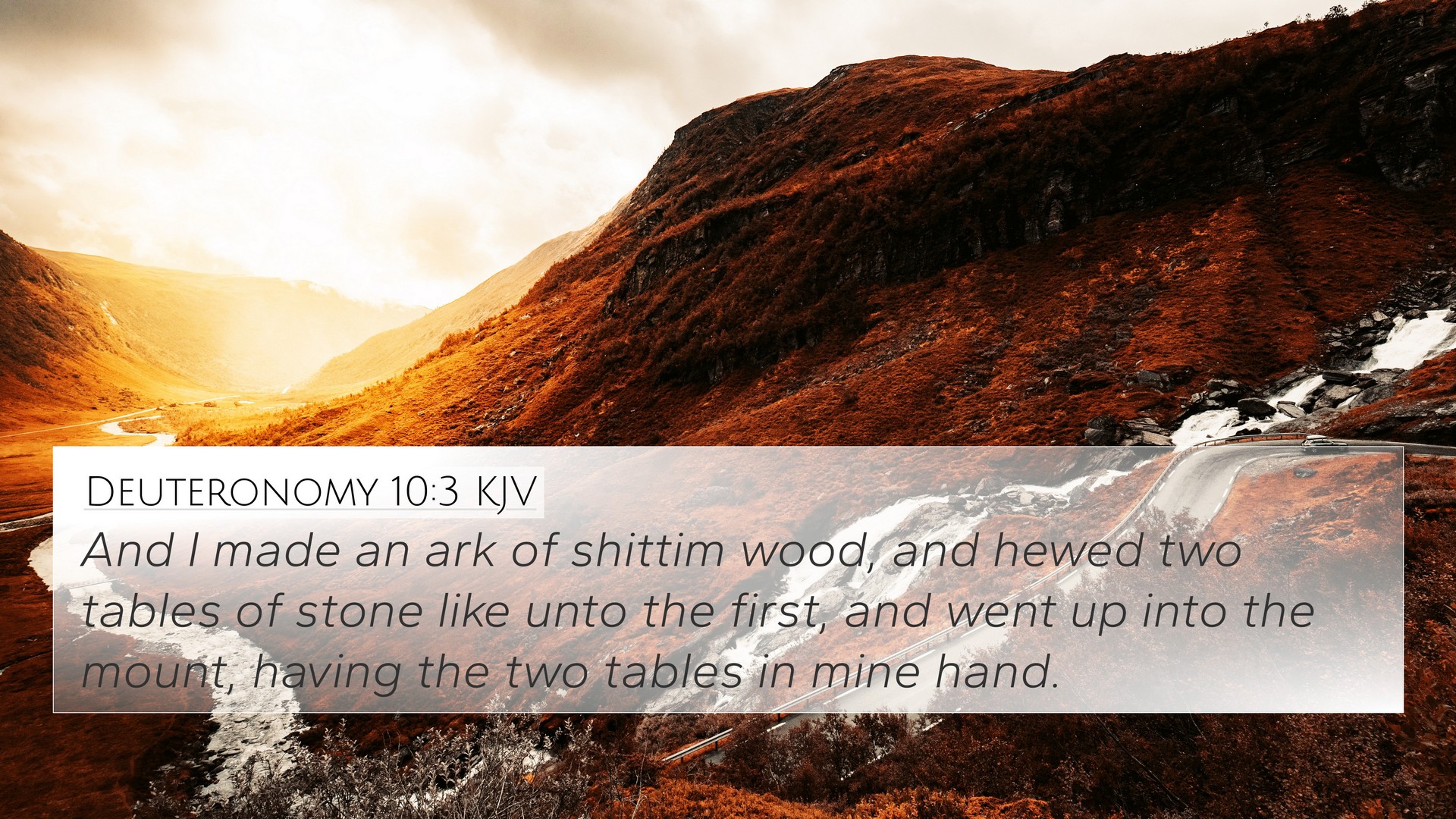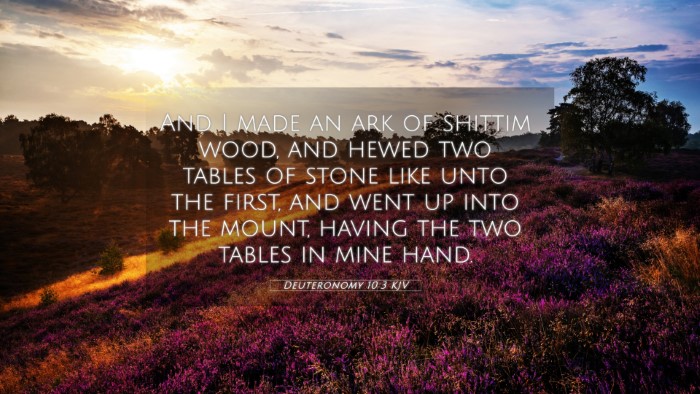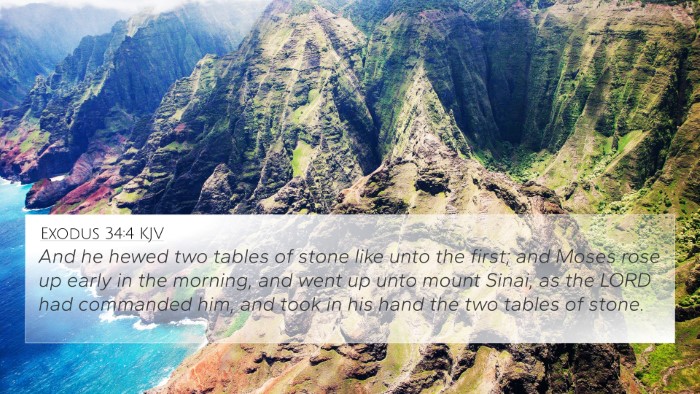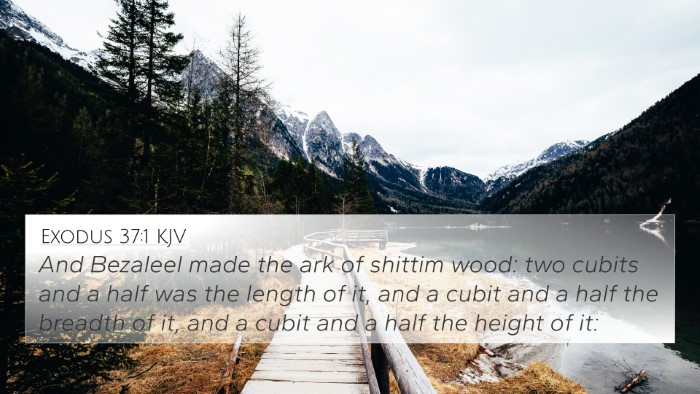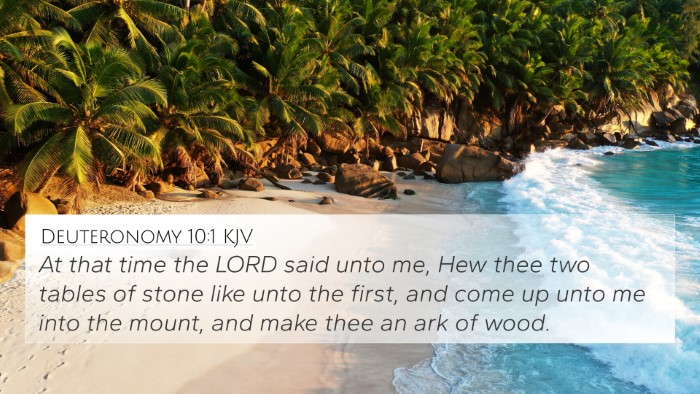Understanding Deuteronomy 10:3
Bible Verse: Deuteronomy 10:3 states, "So I made an ark of acacia wood, and hewed two tables of stone like unto the first, and went up unto the mount, having the two tables in mine hand." This verse describes a critical moment when Moses prepares to receive the Ten Commandments anew, emphasizing the covenant relationship between God and His people.
Summary of Insights
This verse serves as a key point for understanding the continuity of God's covenant with Israel, the significance of the tablets of stone, and the role of Moses as mediator. Here, we explore insights from noted biblical commentators.
Matthew Henry’s Commentary
Matthew Henry highlights Moses' obedience and dedication to God’s command. He points out that the ark of acacia wood signifies the earthly instrument built to house the divine commandments. Furthermore, the act of hewing two stone tablets mirrors the seriousness of God's law, which is both foundational and unchangeable. Henry emphasizes the importance of God's word being preserved and honored, as it signifies divine instruction that guides the moral and spiritual life of the community.
Albert Barnes’s Notes
Albert Barnes discusses the significance of the tablets as a representation of the covenant. He notes that the phrase "like unto the first" implies a restoration, focusing on God's grace in allowing Israel another chance to uphold the covenant. Barnes points out the practical implications of the tablets, suggesting they enshrine the ethical mandates essential for establishing order and morality within the nation. This reinstating shows a pattern of restoration in God's relationship with His people, highlighting His mercy despite their transgressions.
Adam Clarke’s Commentary
Adam Clarke elaborates on the materials used for the ark and the tablets, drawing attention to their durability and symbolic meanings. Clarke explains that the use of acacia wood symbolizes purity and incorruption, while the stone tablets reflect the enduring nature of God's law. He notes the act of going up the mountain as Moses' return to spiritual authority and leadership, signifying a humble submission to God's will. Clarke emphasizes that this act is a vital part of Israel's identity as God’s chosen people, called to obedience and faithfulness.
Cross-References to Deuteronomy 10:3
- Exodus 25:10-16: Description of the Ark of the Covenant and its purpose.
- Exodus 34:1-4: God's instruction for Moses to carve new tablets after the first were broken.
- Deuteronomy 5:22: Reference to the original giving of the Ten Commandments.
- Psalms 119:89: The permanence of God's Word in heaven.
- Hebrews 9:4: Description of the contents of the Ark, relating to the tablets.
- Romans 2:15: The law written on the hearts of men, echoing the importance of God’s commands.
- Jeremiah 31:33: The promise of a new covenant, reinforcing the need for divine guidance.
Thematic Connections
Deuteronomy 10:3 provides rich thematic connections that illustrate the deep relationship between God and Israel, the restoration of covenant, and the continuous call to adherence to God's law. Through the act of restoring the tablets, the narrative speaks to themes of grace, mercy, and redemption. Each cross-reference further enhances this thematic exploration, connecting the Old Testament to teachings within the New Testament.
Tools for Cross-Referencing
For those studying Biblical texts, understanding and utilizing tools for cross-referencing can be invaluable. A few methods include:
- Bible Concordance: A comprehensive index of Bible words and their locations, helpful for finding specific themes and verses.
- Bible Cross-Reference Guide: Resources that offer connections between verses and concepts across the Scripture.
- Cross-Reference Bible Study: A method that encourages exploring links between verses to gain deeper insights into biblical themes.
How to Use Bible Cross-References
Visitors to the Bible can enhance their study by:
- Identifying Connections: Explore relationships between verses across both the Old and New Testaments.
- Detailed Analysis: Conduct comparative studies of verses to understand underlying messages and theological implications.
- Creating Chains of References: Follow thematic threads throughout the Scriptures to see how different writings relate in addressing similar topics.
Conclusion
In conclusion, Deuteronomy 10:3 stands as a testament to God's unchanging nature and the importance of His covenant with humanity. By engaging with the insights of esteemed commentators like Matthew Henry, Albert Barnes, and Adam Clarke, as well as exploring cross-references, readers can deepen their understanding of Scripture’s interconnectedness. The journey through the Bible is enriched by recognizing the vital links between its many verses, leading to a comprehensive grasp of theological themes.
